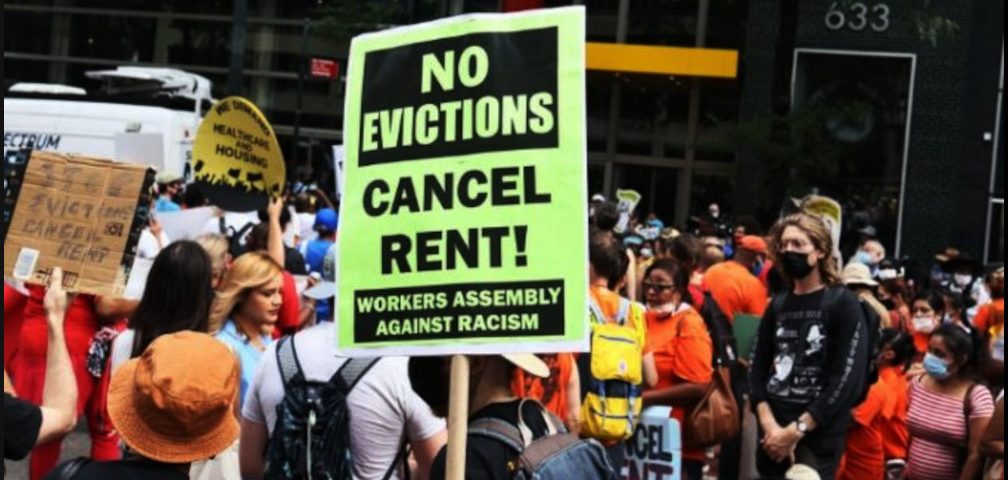by G. Dunkel, published on Workers World, September 13, 2021
Between 2 and 4 million households, out of 80 million rental households, will lose their homes due to evictions in the next two months, according to a survey by the U.S. Census Bureau. This is four times as many as would typically occur nationwide throughout an entire calendar year. (Washington Post, Sept. 3)
The Census report notes that nearly 40% of those at risk have an income of less than $25,000 a year. About the same proportion are Black or Latinx. (tinyurl.com/3umvf7fx)
How many households are dispossessed, and how quickly the process goes, will depend on how quickly local eviction courts work and how many landlords practice “private” evictions with hired thugs. Neither the courts nor the landlords are known for paying any attention to tenants’ rights, especially since the legal framework around property developed centuries ago from feudal courts designed to protect landlords.
The U.S. Supreme Court issued a decision on Aug. 26 to cancel the Centers for Disease Control and Prevention ban on evictions — a decision SCOTUS based on the CDC’s “lack of authority” to make such a ban. Research published by the National Institutes of Health has argued that eviction bans can hinder the spread of COVID-19. While some NIH conclusions are based on models, there is research that supports the conclusion, such as a paper examining the spread of SARS-COV-2 in Philadelphia. (tinyurl.com/e5zuadzj)
Resistance to evictions is growing stronger. In acknowledgement of this mounting socially disruptive problem, some major newspapers — the New York Post and the Washington Post — featured the same picture of a Sept. 4 protest in New York City where the Workers Assembly Against Racism called for “No evictions. Cancel rent!”
Failure of the Federal Rental Assistance Program
Responding to the economic crisis caused by COVID-19, Congress passed a series of emergency rental assistance packages beginning in 2020 that reached a total of $46.5 billion.
The amount allocated to the Rental Assistance Program is about 90% of the total rental arrears by some measures. While the money comes from the federal government, some states and some cities that already have rental assistance programs can apply for this aid and set up programs to disburse it. The response from states that lack existing programs is slower, because they have to set them up.
It appears that only 7% of the money allocated to rental assistance has been disbursed.
The program has been beset by strict requirements — such as requiring landlord-tenant leases, onerous applications and problems in making information available to communities. The program has been met with significant landlord resistance, especially since rents in many areas of the U.S. are spiking, and owners see eviction as a chance to get higher rents.
Millions of renters don’t have leases, especially when they are living in illegal apartments. Los Angeles is estimated to have 200,000 illegal apartments. New York City Mayor Bill de Blasio recently claimed that the city has 100,000 illegal basement apartments. In rural areas, people rent rooms or sheds.
LGBTQ+ renters are faring even worse than the general population. About 1 in 5 of LGBTQ renters are behind on rent, according to an August brief from the Williams Institute. Of that number, nearly half fear they will soon be displaced. (tinyurl.com/2vmcjmbn)
The pressure to disburse more rental assistance more quickly is growing intense, especially with the economy stuttering in reaction to the delta variant.
The CDC eviction moratorium, which ran between Sept. 4, 2020, and July 31, 2021, helped to prevent at least 1.55 million eviction filings across the U.S. That was less than half as many cases as are usually filed over a similar period. (evictionlab.org/eleven-months-cdc)
From mid-March 2020 up until Sept. 4, landlords have filed for 504,892 evictions in six states — Connecticut, Delaware, Indiana, Minnesota, Missouri and New Mexico. The filing was allowable under the CDC ban, which only prohibited actual evictions. Now that the ban is off, these filings can be turned into actual evictions quickly.
Evictions will be a problem for workers in the U.S. as long as workers don’t have the right to a job, health care and housing. Organizing against evictions now is part of the struggle to gain those rights.
